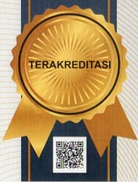Penerapan K-Means Clustering Dalam Pengelompokan Lipstik Matte Lip Cream Berdasarkan Warna RGB
Abstract
Lipstick is the most widely used type of cosmetics and very familiar in the community, almost all make-up brands produce this type of cosmetics. Lipstick colors can generally be grouped into the following: nude, pink, and red. The lipstick used as the object of the study were 10 (ten) samples obtained from NYX Matte Lip Cream Lipstick, from each sample sampled 1 time. From the diversity of colors, lipstick can be grouped into 3 (three), 4 (four) and 5 (five) groups. Based on this, the lipstick will be grouped using the K-Means Clustering method, but before grouping the characteristics obtained with the Euclidean Distance and Coefficient Correlation methods and the combination of various attribute formation are needed. The grouping results using the K-Means Clustering method produces 3 clusters, 4 clusters and 5 clusters where the formation of attributes by Summing up and searching for Average Values is the formation of attributes that produce the same clustering in clustering processes 3 and 4 clusters. The formation of centroid values also affects the results of grouping. The results of the grouping comparison are: grouping 3 clusters produces group A consisting of 8 members, group B and C have 1 different member. And grouping 4 clusters results in a division of groups A and D having 4 different members and groups B and C having each cluster 1 member.
Full Text:
PDF (Bahasa Indonesia)References
N. Adliani, Nazliniwaty, and D. Purba, “Formulasi Lipstik Menggunakan Zat Warna Dari Ekstrak Bunga Kecombrang (Etlingera elatior (Jack) R.M.Sm.),” J. Pharm. Pharmacol., vol. 1, no. 2, pp. 87–94, 2012.
W. Syaifullah, Y. V. Via, and R. H. Setiawan, “Segmentasi Objek Buah Pada Citra Digital Menggunakan Metode K-Means Clustering,” SCAN - J. Teknol. Inf. DAN Komun., vol. X, no. 2, pp. 69–74, 2015.
Y. R. W. Utami, “K-Means Clustering Untuk Pengenalan Buah Berdasarkan Karakteristik Warna Citra,” J. Ilm. SINUS, vol. 9, no. 2, pp. 11–20, 2011.
M. A. Bustomi and Z. Dzulfikar, “Analisis Distribusi Intensitas RGB Citra Digital untuk Klasifikasi Kualitas Biji Jagung menggunakan Jaringan Syaraf Tiruan,” J. Fis. dan Apl., vol. 10, no. 3, pp. 127–132, 2014.
L. Zahrotun, “Analisis Pengelompokan Jumlah Penumpang Bus Trans Jogja Menggunakan Metode Clustering K-Means Dan Agglomerative Hierarchical Clustering ( AHC ),” J. Inform., vol. 9, no. 1, pp. 1039–1047, 2015.
A. B. W. Putra, D. S. B. Utomo, and M. D. Rahmawan, “Verifikasi Golongan Darah Manusia Berbasis Citra Dijital Menggunakan Logika Fuzzy,” J. Sains Terap., vol. 4, no. 1, 2018.
B. Aditya, A. Hidayatno, and A. A. Zahra, “Sistem Pengenalan Buah Menggunakan Metode Discrete Cosine Transform Dan Euclidean Distance,” J. Ilm. Tek. Elektro, vol. 3, no. 2, pp. 134–138, 2014.
A. B. W. Putra and E. Subkhiana, “Ekstraksi Ciri Entropy Untuk Pengenalan Pola Wajah Menggunakan Fuzzy Rule Base,” J. SMARTICS, vol. 2, no. 2, pp. 35–42, 2016.
I. H. Qasim and A. B. W. Putra, “Penggunaan Metode Euclidean Distance , Coefficient Correlation Dan Center Of Gravity Untuk Pembangunan Prototype Ciri Citra Tanda Tangan,” Semin. Nas. Serba Inform. 2017, vol. 1, no. 1, pp. 52–58, 2017.
P. R. Nastiti and A. B. W. Putra, “Perbandingan Algoritma K-Means Dan Fuzzy C-Means Clustering Untuk Kualifikasi Data Kinerja Dosen Di Jurusan Teknologi Informasi POLNES,” Semin. Nas. Serba Inform. 2017, vol. 1, no. 1, pp. 71–76, 2017.
DOI: https://doi.org/10.32487/jst.v5i1.527
Refbacks
- There are currently no refbacks.
Copyright (c) 2019 JST (Jurnal Sains Terapan)
View My Stats


